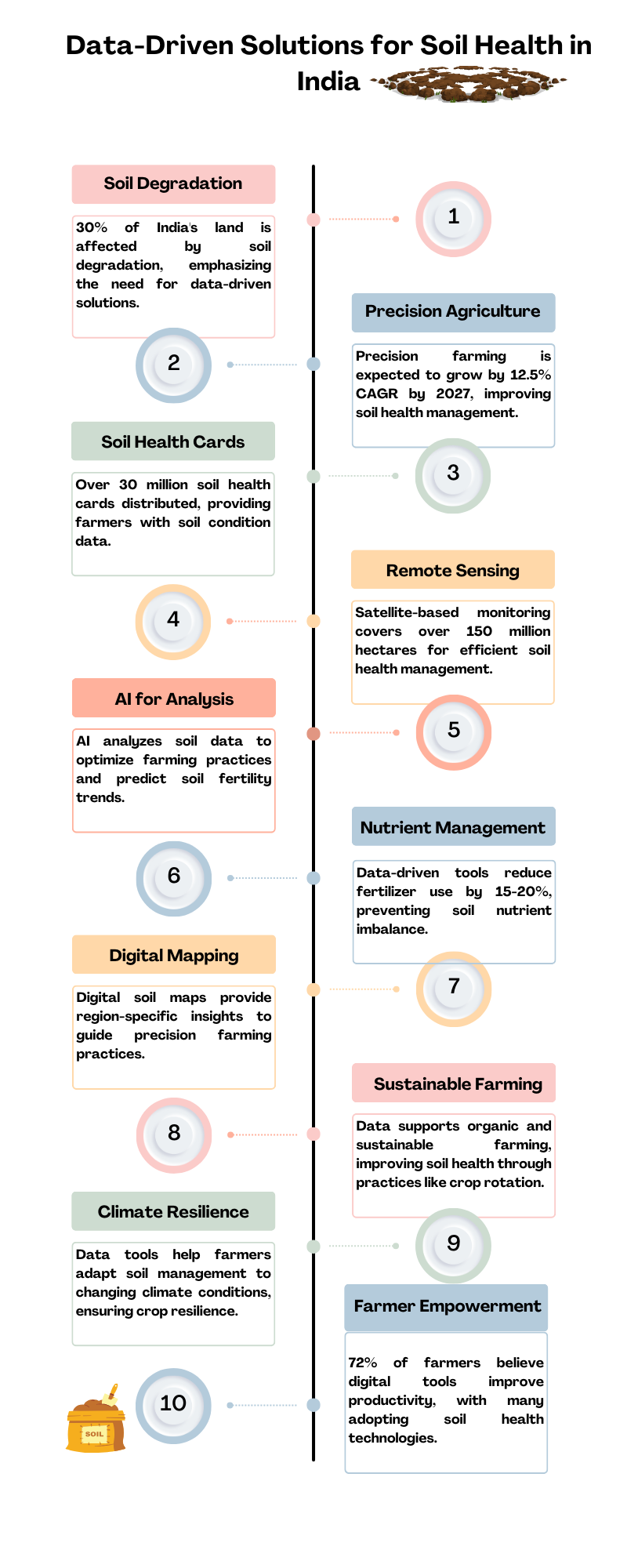Soil health is essential for supporting ecosystems, ensuring the availability of clean water, and enhancing air quality, all of which ultimately impact human health. As awareness about the importance of soil health grows, technological innovations have significantly transformed how we monitor and manage it.
Traditional soil assessment techniques have evolved, and data-driven, precision-based technologies now offer deeper insights into soil conditions. This article examines the latest advancements in soil health monitoring, focusing on new soil testing technologies and their implications for sustainable agricultural practices.
The Critical Role of Soil Health
Soil health is not merely about plant growth but also involves maintaining soil’s functional capacity to deliver critical ecosystem services such as nutrient cycling, water retention, carbon sequestration, and biodiversity conservation. While earlier efforts mainly concentrated on soil fertility, modern approaches consider the broader aspects of soil health, which include soil structure, microbial activity, organic matter, and nutrient availability. Healthy soils contribute to the overall well-being of plants, animals, and humans, supporting a balanced ecosystem and addressing challenges such as climate change and food security.
Challenges of Traditional Soil Testing
Traditional soil testing involves sampling the soil, sending it to a lab, and analyzing its nutrient content, pH, and organic matter levels. While this method has been useful, it has limitations. Laboratory tests can be costly and time-consuming, especially when analyzing large agricultural fields. Furthermore, traditional methods may not provide real-time information, which can delay decision-making regarding irrigation, fertilization, or pest control.
In addition, these tests often focus narrowly on soil fertility without considering other essential factors, such as microbial activity and soil structure. This has led to the development of more comprehensive, data-driven technologies to better monitor soil health.
Modern Soil Health Monitoring Technologies
The latest advancements in soil health monitoring have significantly increased our ability to gather real-time, accurate data on soil conditions. These innovations empower farmers to make more informed, immediate decisions that improve efficiency and sustainability. Several technologies are now integral to modern soil health management, including sensors, spectroscopic methods, drones, and AI-powered platforms.
Sensors: Real-Time Monitoring of Soil Conditions
Various types of sensors have revolutionized soil health monitoring by providing real-time data on different soil parameters. These sensors are designed to assess soil characteristics, allowing farmers to manage their fields more effectively.
Key types of soil sensors include:
Location Sensors (GPS): These devices track the precise location of agricultural assets and help create accurate soil and yield maps for precision agriculture.
Optical Sensors: These sensors monitor plant health by measuring sunlight reflectance (albedo), providing insights into plant canopy health and global warming potential.
Electrochemical Sensors: These sensors measure soil pH, nutrient content, and even pollutants, offering valuable information for effective soil management.
Mechanical Sensors: Devices such as penetrometers measure soil compaction by evaluating the resistance of the soil to penetration, helping farmers identify issues like compacted layers that may hinder root growth.
Dielectric Soil Moisture Sensors: These sensors provide real-time monitoring of soil moisture levels, allowing for precise irrigation management.
These sensors transmit data wirelessly, enabling farmers to make immediate decisions based on the conditions of the soil. As these technologies become more affordable and accessible, they enable farmers to optimize their operations and reduce waste.
Spectroscopic Methods: Advanced Soil Analysis
Spectroscopic techniques have gained prominence due to their ability to offer detailed, non-destructive analysis of soil. These methods analyze the interaction between electromagnetic radiation and soil, allowing for rapid, in-field testing. Some of the key spectroscopic methods used for soil health monitoring include:
Laser-Induced Breakdown Spectroscopy (LIBS): This technique uses a focused laser to ablate the soil, creating plasma that emits light with unique elemental signatures. LIBS can detect soil elements such as calcium, iron, magnesium, and carbon.
Infrared Spectroscopy: Techniques like near-infrared (NIR) and mid-infrared (MIR) spectroscopy measure light absorption at specific wavelengths, providing insights into the organic and mineral composition of soil.
Visible-Near Infrared (Vis-NIR) Spectroscopy: This method allows for rapid, simultaneous analysis of several soil properties such as moisture content, organic matter, and texture.
These methods enable rapid, high-throughput analysis in the field, making them ideal for continuous monitoring of soil health. They also support carbon sequestration efforts, an important aspect of climate change mitigation, by enabling efficient tracking of soil organic carbon levels.
Drones and UAVs: Precision Agriculture Tools
Drones and unmanned aerial vehicles (UAVs) are becoming vital tools for soil health monitoring, particularly in large-scale agricultural operations. Equipped with specialized cameras and sensors, drones provide high-resolution data that helps assess soil conditions and plant health.
Drones offer several advantages:
High-Resolution Imaging: Drones capture images in various wavelengths, including visible and near-infrared light, to assess plant canopy health and detect early signs of nutrient deficiencies, stress, or disease.
Digital Soil and Plant Canopy Maps: The data collected by drones is processed using algorithms and GIS technologies to create detailed digital maps of fields. These maps provide valuable insights into soil conditions, helping farmers make precise decisions regarding fertilization, irrigation, and pest control.
Timely Insights: Unlike satellite imagery, which may not provide frequent updates or high resolution, drones offer real-time data that allows for immediate intervention and efficient resource management.
By enabling precise, real-time monitoring of vast agricultural landscapes, drones help farmers improve productivity, reduce costs, and minimize environmental impact.
AI and Machine Learning: Transforming Soil Health Management
Artificial intelligence (AI) and machine learning (ML) are transforming agriculture by enabling better data analysis and decision-making. These technologies can process vast amounts of data from sensors, drones, and spectroscopic tools, providing valuable insights into soil health and helping farmers optimize their practices.

AI and ML offer the following benefits:
Enhanced Decision-Making: AI algorithms analyze data to identify patterns and trends in soil conditions, enabling farmers to make more informed, data-driven decisions on soil management, irrigation, and fertilization.
Predictive Analytics: AI models can predict changes in soil health based on factors such as weather conditions, crop rotation, and fertilizer use. This helps farmers anticipate and manage soil issues before they impact crop yield.
Scalability: AI and ML technologies can be applied across a wide range of farming operations, from small family farms to large industrial operations, making them highly versatile and accessible.
These technologies streamline soil health management by providing actionable insights based on comprehensive data analysis, thus enhancing the overall efficiency of agricultural practices.
Future Trends in Soil Health Management
As technology continues to evolve, the future of soil health management looks promising. Several emerging trends are expected to shape the future of soil health monitoring and management.
Increased Integration of Digital Soil Mapping: As monitoring technologies become more affordable, digital soil mapping is expected to become more widespread. These maps enable farmers to assess soil conditions in greater detail and tailor their management strategies accordingly.
Blockchain for Soil Data Transparency: Blockchain technology could be used to track and verify soil health data, ensuring its authenticity and providing transparency across the agricultural supply chain. This would help build consumer trust in sustainable farming practices and offer valuable data for policy development.
Climate Change Mitigation through Soil Monitoring: Monitoring soil organic carbon and improving soil carbon storage will be a key focus in efforts to mitigate climate change. Technologies that enable real-time tracking of carbon sequestration will become increasingly important.
Affordable Monitoring Tools for Small Farmers: As technology continues to improve, soil health monitoring tools will become more affordable, allowing small-scale farmers to adopt data-driven practices that improve soil health and boost productivity.
Conclusion
Technological advancements in soil health monitoring and management are revolutionizing agriculture, making it possible to monitor soil conditions more accurately, efficiently, and in real-time. Sensors, spectroscopic methods, drones, and AI are all playing key roles in helping farmers make informed, data-driven decisions to improve soil health and productivity.
These technologies not only promote sustainable farming practices but also contribute to global efforts to address climate change and food security. As soil health continues to be recognized as a critical component of environmental sustainability, these innovations will play an increasingly important role in ensuring the long-term health and productivity of our soils.


Leave a Reply